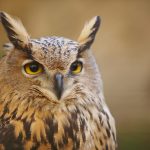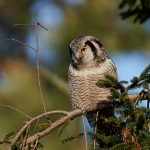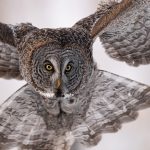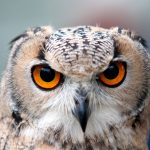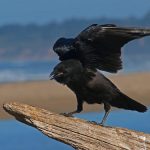Owls are widely considered to be among the world’s most intriguing and enigmatic birds of prey. There are over 200 different species of owls that can be found on every continent on the planet, with the exception of Antarctica. There are only 19 different species of owls that are found in the wild in the United States and Canada, while Asia has the highest variety of owls.
They have various unique characteristics that assist them search for prey at night, such as highly developed binocular eyesight and accurate flying ability. These traits allow them to hunt more effectively. In this essay, we will discuss some fascinating information regarding the owl’s identity, habitat, and physical characteristics.

Crows are number of different black birds that are glossy and may be seen in most regions of the world. Crows are dark birds that are well-known for their intellect and their ability to adapt, as well as for their harsh and loud calls. They also have a reputation for causing damage to crops; however, it appears that the extent of this damage may be less than first believed.
Crows, ravens, and rooks are all classified under the genus Corvus. These birds are all related to one another through their membership in the Corvidae family. Other members of this family include jays, magpies, and nutcrackers.
| Character | Owl | Crow |
| Size | Height: 10 in-30in | Height: 6 in-10 in |
| Weight | 0.5 Kg-4.1Kg | 0.4kg-0.6kg |
| Wingspan | 21in-70in | 20in-35in |
| Active time | Nocturnal | Diurnal |
| Beak or mouth | Curved, Short and sharp | Large, pointed and sharp |
| Life span | 5-10 years | 4-20 years |
| Skin type | Downy soft feathers | Black feathers |
| Speed | 24mph | 59mph |
Difference between Owl and Crow on the basis of Appearance
Different species of Owls comprises different shapes, sizes, and colors. They have two stationary, forward-facing eyes with facial discs around them, a flat face, a pointed beak, long and rounded wings, short tails, and two stationary, forward-facing eyes with facial discs surrounding them. Crows are huge birds with strong legs and straight, hefty beak. These birds, including their legs and feet, are completely black. They have opalescent feathers on their upper backs, which are especially noticeable in the sunlight.
Difference between Owl and Crow on the basis of Behavior
Owls, like many other birds, tend to live in couples or small family groups. Each year, the same pair of parents raises a new brood. When they aren’t reproducing, they may form larger flocks to protect themselves and their young.
Crow forms gatherings sometimes referred to as a “murder,” this flock of bird’s travels in large numbers. There are typically roughly ten birds in a flock, although there may be far more than that. They employ a variety of cries to warn one another of potential dangers in their natural environment.
Difference between Owl and Crow on the basis of Size
These Owls come in a variety of sizes. The elf owl is the smallest species on the planet, being about 5 to 6 inches tall. The world’s largest species, the Blakiston’s fish owl, stands over 2 feet tall and has a wingspan of nearly 6 feet.
The crows have a height of between 4 and 6 inches and their length ranges from 16 to 20 inches from the tip of the beak to the feathers on the end of their tails. They weigh between 0.4 and 0.6 kg each.
Difference between Owl and Crow on the basis of Speed
When it comes to flying speed, the Great Horned Owl beats out all other owl species hands down. When it takes to the air, the Great Horned Owl is capable of reaching speeds of up to 40 miles per hour.
The majority of corvids, if not all of them, have heads that are structurally disproportionately large to the rest of their bodies, which suggests that their brains are also disproportionately huge. Crows may reach speeds of up to 60 miles per hour when flying.
Difference between Owl and Crow on the basis of Wingspan
The wingspans of several owl species differ significantly. The wing span of the Great Grey Owl is between 4.5 and 5 feet. The wing span of the Great Horned Owl is 3.3-4.75 feet. A Snowy Owl’s wingspan is between 4 and 6 feet. The wing span of a barn owl is between 3.25 and 4 feet.
The American crow is a huge bird with iridescent black feathers that cover its entire body. It has black legs, feet, and a black bill. They are 16–21 inches long, with the tail accounting for around 40% of the total length. The wing chord measures 9.6 to 13.0 inches, while the wingspan measures 33 to 39 inches.
Difference between Owl and Crow on the basis of Habitat
Owls can be found in coniferous forests as well as mountains, the deserts, and plains. The snowy owl lives on the tundra of the northernmost regions. Owls build their nests in a wide range of locations. Great grey and great horned owls can be found in old hawk or squirrel nests.
Crows thrive in agricultural and grassland settings where they may hunt for food. American crows will also breed and roost in surrounding woodlots and forest borders.
Difference between Owl and Crow on the basis of Beak
The beaks of owls are small and curved, with a downward curvature and a hooked tip at the end. Its primary function is to grasp and shred everything that comes into contact with its jaws. The crushing strength of the beak is often used to dispatch the prey after it has been successfully captured.
The beak of a crow is pretty broad and measures around 2 and a half inches in length; it is pointed and sharp, although it is shorter than the beak of the raven.
Difference between Owl and Crow on the basis of Beak
Owls are predatory birds, which means they must kill other creatures in order to survive. Their diet includes insects, spiders, earthworms, snails, and crabs, as well as fish, reptiles, amphibians, birds, and small mammals.
Crows consume a wide range of foods. They will consume practically everything because they are omnivores. Their dietary constraints are rather lax, allowing them to consume a wide variety of foods including as seeds, grains, rodents and other animals, tiny fish, reptiles, and even other birds.
Difference between Owl and Crow on the basis of Active time
The majority of owl species are nocturnal, meaning that they are most active at night. However, certain owl species are diurnal, meaning they are awake during the day but sleep at night.
Crows appear to be most engaged in feeding behavior early in the morning and then again in the afternoon, with a form of sporadic foraging occurring in between these two times.
Difference between Owl and Crow on the basis of Lifespan
When living in the wild, owls typically only live between five and twelve years, but when domesticated as pets, their lifespans can extend by a significant amount.
In the wild, crows have life expectancies that range from 4 to 7 years to 22 years or more. The Carrion crow lives only 4 to 7 years in the wild, but the American crow can live up to 15 years and the Torresian crow up to 20 years. Crows have a significantly longer life expectancy in captivity.
Can we keep Owl and Crow as pets?
Despite the fact that novels and movies have helped popularize the idea of keeping owls as pets, the truth is that keeping owls as pets is not a smart idea.
The harsh reality is that crows are terrible pets in any situation. They’re simply not designed to live in captivity.
Do Owls Have Better Color Vision Than Crows?
Owls’ color vision explained: While crows possess excellent color perception, owls have an advantage due to their unique adaptations. Owls are primarily nocturnal hunters, relying on light levels rather than color cues. Their visual system is optimized for low-light conditions, enabling them to detect prey effortlessly in the dark. Thus, while both birds have remarkable visual abilities, owls’ color vision may be less developed compared to crows.
Are Owls’ Legs Longer or Shorter than Crows’?
When it comes to owl leg length versus crows’, the former tends to be longer than the latter. Owls have relatively long legs, which allow them to perch higher and navigate through dense forests with ease. Crows, on the other hand, have shorter legs that are adapted for hopping and walking on the ground.
Who is more intelligent an Owl or Crow?
Owls do not have such large, well-developed brains and have not demonstrated above-average intellect when tested in captivity. The concept of the intelligent owl may have originated in Western cultures because Athena, the Greek goddess of knowledge, is frequently depicted with an owl on her shoulder.
Corvids (songbirds such as ravens, crows, jays, and magpies, to mention a few) are among the most intelligent birds, yet common ravens may have the upper hand when it comes to solving difficult problems.

